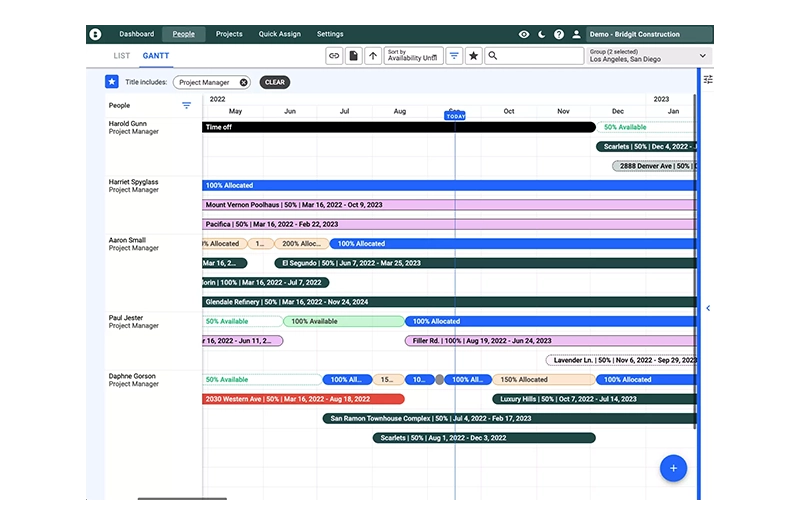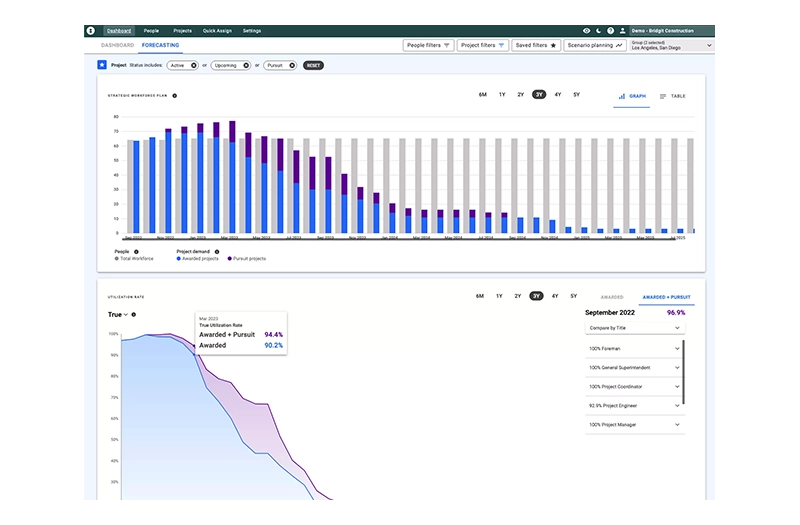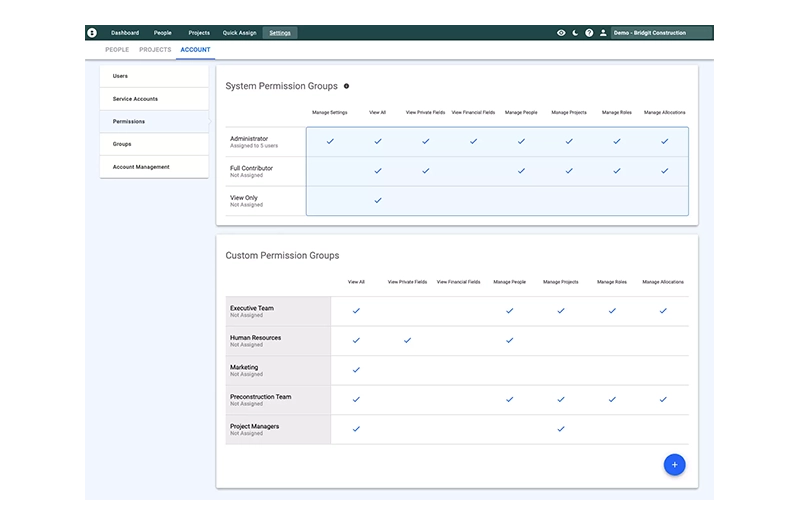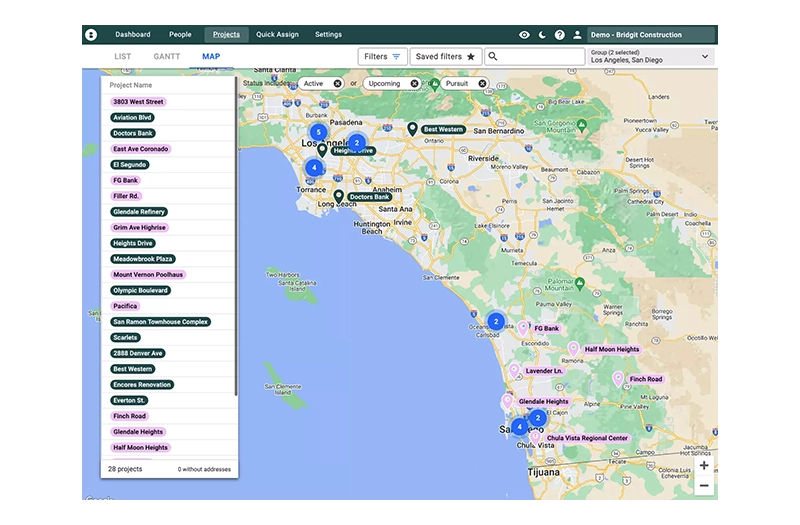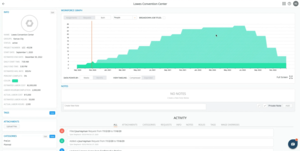Bridgit Bench vs. LaborChart

Bridgit Bench vs. LaborChart: Overview
Bridgit Bench
Available platforms
- Web/Cloud-based
- Mobile applications for iOS and Android
Target audience
- Enterprise general contractors, self-perform general contractors, specialty contractors, subcontractors, small-midsized general contractors
Customer support availability
- Online Bridgit Help Desk
- Dedicated Account Manager
- FAQ and tutorials
- Handles implementation for you
LaborChart
Available platforms
- Web/Cloud-based
- Mobile applications for iOS and Android
Target audience
- Subcontractors and craft workers in the construction industry
Customer support availability
- In-app support
- Online chat
Bridgit Bench features & integrations
Because construction is so dynamic by nature, Bridgit Bench has quickly become the leading resource management and workforce planning software because of its flexibility and ability to be customized to meet the needs of every general contractor, self-perform contractor, subcontractor, and specialty contractor in construction. Bridgit Bench helps to mitigate project risk, save countless hours each week maintaining data, and help to push an organization’s needle in the right direction.
Bridgit Bench has refined the resource management process with powerful features designed to streamline core operations and provide general contractors with actionable insight into their workforce allocations and utilization. Contractors across North America, Australia, New Zealand, and the UK are using Bridgit Bench to improve team collaboration and alignment on their workforce planning goals and strategy.
Bridgit Bench helps to streamline core operations and is proven to save time, mitigate project risk, and increase an organization’s bottom line.
Features included with Bridgit Bench are:
- Customizable Project and People Gantt views
- Project phase-based resource planning
- Tracking for both salaried and hourly team members
- Smart allocation suggestions
- Forecasting and allocation dashboards
- Custom reports
- Custom permission groups for controlled transparency
- Procore integration and Embedded app
- Autodesk integration and partner card
- Low-code-no-code, pre-built integrations
Bridgit Bench has an Open API that allows organizations to integrate their resource planning with their existing tech stack. It also supports integrating with Procore software and is available as an embedded experience within the Procore app.
Pros and cons of Bridgit Bench
PROS
Bridgit Bench is user-friendly and easy to use. It allows general contractors to quickly update staffing changes common to the construction industry and provides accurate visualization tools for creating efficient, strategic, forward-looking workforce plans. Its user-friendly interface allows for the consolidation of multiple, error-prone spreadsheets commonly used for resource management. Bridgit Bench helps to improve collaboration by providing unlimited users with controlled access to accurate, actionable project and allocation data via web-based or mobile applications.
Bridgit Bench supports phase-based resource management. Users are able to create custom phases to track how their projects evolve over time and can allocate team members directly to specific project phases. Phase-based resource management also provides users with greater control over workforce allocations when project and phase dates shift.
Bridgit Bench helps to ensure you’re allocating the right person for the job. When placing a person on a project, Bridgit Bench will filter your team by title and availability and indicate if an allocation issue will be created by allocating specific team members. Users can also apply additional filters for any data fields related to their people such as region or skills and experience.
Bridgit Bench has a robust “Groups” feature set that allows users to create custom groups to quickly segment both their people and project data by different offices, regions, divisions, or departments. These groups are perfect for enterprise GCs to provide greater transparency across the organization, while still having the ability to reduce the extra clutter when focusing on specific offices.
Bridgit Bench has a “time off” feature set that allows users to create extended periods of unavailability. Individual periods of unavailability are then reflected throughout Bridgit Bench to prevent the allocation of unavailable team members and allow contractors to easily replace unavailable team members on their respective projects.
Bridgit Bench was built for construction and is responsive to client needs. Our implementation team has contractors up and running with their workforce and project data within 2 weeks. Bridgit works with clients to update existing features and create meaningful new features to satisfy the needs of the industry. Read the case study on Andres Construction to learn how having a workforce management tool contributed to its growth in the industry.
CONS
Bridgit Bench is currently only available in North America, New Zealand, Australia, and the UK.
LaborChart review: Features & integrations
While Bridgit Bench is built specifically for contractors of every kind in the construction industry, LaborChart was primarily built for subcontractors with its hourly allocation abilities.
Features included with LaborChart are:
- Scheduling and dispatching
- Labor requesting
- Certifications and tagging
- Forecasting
- In-app messaging
- Reports/exports
LaborChart also has an open API and supports an integration, and embedded app, with Procore software.
Pros and cons of LaborChart
PROS
LaborChart is great for contractors looking to reduce labor waste with their subcontractors and hourly trades/craft workers. Its mobile application allows users to stay up to date in regards to their resource planning, and message relevant stakeholders when changes are made.
LaborChart has a ‘workforce graph’ for each project that shows the expected vs actual labor over the duration of the project.
LaborChart also supports notifications via text or email to communicate labor requests and dispatching team members.
CONS
With an emphasis on hourly allocations, LaborChart isn’t ideal for general contractors or subcontractors working on medium-large projects. LaborChart is optimized for shorter project assignments and isn’t ideal for contractors that are planning longer-term project assignments (3+ months).
When allocating resources, LaborChart requires you to know the name of the specific person you’re hoping to allocate. With no insight into their title or availability, it becomes difficult to manage resources effectively without creating overlapping allocation issues.
LaborChart doesn’t support project phases. With how fluid construction projects are, not supporting project phases leads to time-consuming manual updates to assignments when project dates need to be shifted.
LaborChart also has minimal support for project pursuits and scenario running. If you’re a contractor that is looking to plan around future projects and better understand the impact a pursuit will have on your resource strategy, LaborChart might not be the best-fit solution for you.
LaborChart can take up to two months to be fully operational. This long implementation process means a longer wait until clients start seeing the fruits of their labor.
LaborChart is also likely too specific in its use case for companies seeking general workforce management tools.
Bridgit Bench vs. LaborChart comparison: Screenshots
Bridgit Bench
LaborChart
User reviews
BRIDGIT BENCH REVIEWS

“Really enjoy using it. It is a big upgrade from some of our guys using excel sheets.”
“Investing in Bridgit Bench has been a no brainer. It’s one of the technologies we’ve invested in that is a driving factor to our growth. You can get to it from wherever you are, and it doesn’t take an arduous amount of time like the Microsoft Excel spreadsheet.””
“Bridgit is simple to use, intuitive and the mobile piece lends itself to up to the minute data for real-time conversations with employees. The sorting features make it simple for each user to see what is important to their department and for each department to be pulling from the same information. Can’t say enough good things about this program.”
“Bridgit is very aware of the construction market and knows our needs before we do.”
LABORCHART REVIEWS
“The ability to keep everyone aligned at that calculated daily cost–not to mention the ROI from reduced labor waste–it’s a no brainer.”
“LaborChart solves many problems with workforce challenges.”
“Bridgit Bench is like using an iPhone, LaborChart is more like using Linux”
“One challenge with LaborChart is the manual changes you need to make when construction is fluid. Constantly deleting, adding, and manipulating data.”
Why choose Bridgit Bench over Laborchart?
Bridgit Bench is the leading workforce management tool for construction because, unlike LaborChart, it was built to satisfy the needs of general contractors of all sizes. While LaborChart does have the ability to assign hourly team members, this can add a level of complexity that most general contractors do not need when allocating their trackable resources.
Bridgit Bench helps general contractors eliminate the countless hours of spreadsheet upkeep while surfacing information relevant about resource allocations to streamline the process and build stronger project teams. Bridgit Bench enables high-level collaboration, phase-based resource management, and transparency without the risk of unwanted changes. It also provides flexibility to configure the software to suit your business, and most importantly its ease of use allows for a fast implementation process so you never miss a step. To learn more about the advantages general contractors have unlocked through Bridgit Bench, check out our case studies.

